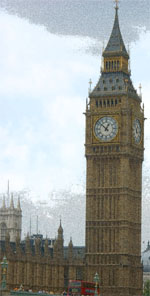DPR Voting - simple, practical electoral reform
|
| How many votes in parliament should a party that gets 3.7m votes in a General Election get? 11? How many votes in parliament should a party that gets 1.2m votes in a General Election get? 48? . So ....Three times the number of votes, less than a quarter of the seats. This is a flawed voting system. It is not fair or democratic. |
|
|---|---|
| You know the Party that you want to support. You want to have the best MP as your local champion. Sometimes the best candidate is not in your party, or is standing as an independent. The voting system makes you choose party or candidate. This is how we end up electing bad MPs. |
|
|||
|
||||||||||||||||||||||||||||||||||||||||||||||||||||||||||||||||
| The First Past the Post (FPTP) system is used to elect MPs to the House of Commons, and therefore determines which party or parties will form the Government in the UK.
It is also used in Canada, the USA and some other countries.
It is a simple system. The country is divided into small geographical areas – constituencies - which, in theory, have a similar number of voters. In a General Election there is a vote in each constituency to elect an MP. Each political party can put forward a candidate, (but they may choose not to). Independent candidates can also put themselves forward. In the election each voter has a single vote to cast for one of the candidates. The candidate that gets the most votes is elected. It is worth noting that in a General Election under FPTP, no one votes directly for a Party, a Prime Minister or a Government. You can only cast a vote for an individual candidate to be elected as an MP. Voting directly for the party is a feature of PR systems such as MMP/AMS, List PR and DPR Voting. The advantages of FPTP are • Simple Voting - voting is simple to understand and simple for the voter to take part. • Simple Counting - It is simple to count the votes and understand the result, and counting can be done very quickly. • Single member constituency - The single member constituency allows electoral scrutiny of candidates, engagement with a local campaign and encourages a strong link between the MP and the constituents. More contentiously from a democratic standpoint, • 'Strong' Government: FPTP tends to result in an artificially large majority of MPs in parliament for the most popular party at the expense of minority parties. As a result a single party is more likely to be able to form a Government with a majority in the parliament and be able to push through its political programme without the need for coalition, agreement or compromise with the opposition parties. This is contentious because a large government majority may not appear to be justified by the popular votes cast. Arguably 'weak opposition' is the reverse side of the 'strong government' coin, and it seems doubtful as to whether this is desirable in a parliamentary democracy. • Makes it easier to change from one Government to another with a very small change in the overall popular vote. This is contentious because the result can be a pendulum-like change limited to government by one large party followed by the other. • Keeps extremists out of parliament. An extremist party is less likely to be represented in Parliament. This also applies to other small or new parties, unless they happen to have geographically concentrated support. This is contentious because some argue that the nature of democracy is that minority opinions should be heard in the parliament, and not excluded by the way the electoral system counts the votes. The disadvantages of FPTP are • Not a PR system. There is no proportionality between the number of votes a party gets in the election and the number of seats it gets in the parliament. • A clear mandate? A party may form a Government even though it does not have a majority of the popular vote. • Bizarre results: It is possible for a party that did not get the largest number of votes to have the largest number of seats (this happened in 1929, 1951 and 1974). • Unfair to minor parties: Minor parties may have proportionately far fewer MPs than their share of the popular vote would seem to deserve. eg UKIP, Green, and Lib Dem parties in 2015 • Regional parties can be over represented eg the SNP in the 2015 General Election, and the parties of Northern Ireland. • Safe Seats: Some constituencies are safe party seats and do not change hands. This can weaken the link between MP and constituents. In such a constituency voters can feel that there is no point in voting, and an MP may feel that election can be taken for granted. • Marginal Constituencies: The converse of this is that the election may be decided by a relatively small number of voters in a handful of ‘marginal’ constituencies. • Sensitive to boundary changes: How constituency boundaries are drawn (combined with demographic changes) may affect the outcome of the election. To maintain the electoral system, boundaries require regular revision by an independent commission. Alternative Electoral systems Alternative electoral systems in use include • STV - used in Ireland, Malta, Australia, • MMP / AMS - used in Germany, New Zealand, Scotland, Wales etc, • PR list systems - widely used, eg Finland, Latvia, Sweden, Israel , Brazil, the Netherlands, Russia, and elections to the European Parliament. The disadvantages of FPTP taken in isolation are considered undesirable by many, but the system continues to be used because of its advantages - simple voting and counting, and the democratic accountability and simplicity of the single member constituency. It is argued that both MMP and STV are fairer systems, but they have failed to attract majority support. This is mainly because their disadvantages are contentious, and prevent the formation of a consensus. • MMP needs larger constituencies than FPTP and, as a consequence, boundaries have to be redrawn.This means larger work loads for constituency MPs. The alternative is an increase in the number of MPs, which is usually not acceptable. With this system, there are two types of MP. MPs elected in a constituency, and MPs elected from the party list process. • STV requires large multimember constituencies and this results in a different relationship between voter and MPs. Voting is preferential, and thus more complicated. A particular feature is the very complicated counting procedure. Note: STV is not technically a PR system (and can end up with the party with fewer votes getting a majority - see the Malta experience) but usually gives a result close to 'PR'. • PR List systems which may be open list or closed list have not attracted much support as a system to replace FPTP in the UK. see Advantages and disadvantages of FPTP (2) see also Voting systems compared. |
||||||||||||||||||||||||||||||||||||||||||||||||||||||||||||||||
Why is FPTP still used?Two important reasons that people support FPTP are a) FPTP has some attractions that most PR systems don’t have b) The opposition to FPTP is fragmented rather than united. Electoral reformers do not argue a case designed to win over those who would otherwise support FPTP. Rather they split into separate camps to argue the case that their preferred electoral system is the best available, and ignore the reasons why people like FPTP. The separate camps argue against themselves because electoral reformers cannot agree on which electoral system to support. The attractive features of FPTP are 1 Simple voting and counting. 2 The single member constituency. When the alternative (choice of voting system) is complex and unfamiliar, many people prefer to keep the simple system they know. If you change the single member constituency system it changes the relationship between the MP and the electorate. In addition, the MPs affected feel threatened by any change suggested to the boundaries of their constituency . Thus either for reasons of self interest or fear of the complex, people accept the status quo. |
||||||||||||||||||||||||||||||||||||||||||||||||||||||||||||||||
|
||||||||||||||||||||||||||||||||||||||||||||||||||||||||||||||||
As a system for choosing a single winner such as a constituency MP, FPTP is simple and straightforward. Voting and counting are very simple and the single member constituency has real advantages. There are good arguments for other ways of electing a single winner in a constituency, but FPTP is the simplest.
Conservative 10.7m votes - 306 seats, Labour votes 8.6m - 258 seats, Lib Dem 6.8m votes - 57 seats.
|
DPR voting has the advantages of FPTP without the disadvantages
FPTP is not a proportional system. The strength of the parties in the Parliament is highly unlikely to reflect the votes cast in the General Election. Third parties with thinly spread support suffer badly. Conversely, parties with concentrated support in a small area can be over represented. If the two largest parties are closely matched, the Government is not necessarily formed by the party that wins the most votes. FPTP can give victory to the party with the fewer votes.
FPTP tends to result in a two party system.
There are no prizes for coming second. FPTP tends to produce a competition between two larger parties with third and other parties being squeezed out. see Duverger's Law.
FPTP tends towards a two party system, and politicians tend to portray complex issues as black and white. Party advantage tends to drive the debate.
The voter has one vote both to express a preference for one candidate, and at the same time, one party to form the Government. For this reason it is not clear that the results reflect the will of the people . Where there are several candidates from several parties a minority of votes is often enough to elect the ‘winning candidate'. All the voters who did not vote for the winning candidate, often a majority, contribute nothing to their choice of party's strength in the Parliament, or to electing a Candidate.
Frustrated voters inevitably try to exploit the flaws of the system. This can result in voters deliberately voting for a party they do not want to form the Government, as a way of voting against a rival party when it is clear that otherwise their vote will be wasted.
Minor parties with a significant share of the popular vote nationwide but with widespread rather than concentrated support may be under represented in the parliament, or even have no representation.
The result of a closely fought FPTP election is decided by the votes cast in a few marginal constituencies. Parties therefore direct their resources disproportionately to these areas. This can border on the corrupt, or the suspicion of corruption when resources are diverted to a marginal constituency instead of another similarly qualified area.
FPTP results in safe seats where the incumbent MP appears to be fireproof. This happens where there is especially strong support for a particular party. Even a poor candidate may be elected because supporters of that party feel they must vote for the party. Supporters of other parties may feel their vote is wasted, or that there is no point in voting. If re-election is virtually automatic, the MP may not give the attention to the constituency that it deserves.
Under FPTP the vote for the MP is conflated with the vote for the Government. In a General Election, it is very difficult to be elected as an independent because the electorate is focused on electing a party to form the Government. The exception is in a by-election when the future of the Government is not at risk. One advantage of FPTP for the independent candidate is that the single member constituency, being smaller than a multimember constituency, makes it easier for the independent candidate to campaign.
Under FPTP the party label is crucial to a candidates electoral campaign. If a party should decide to deselect an MP, they have little chance of being re-elected as an independent. Thus the MP's future employment depends on the party, and as a result party whips have a lot of power. Conversely the Party also has the power of patronage. The Central Party organisation, by appointing a candidate to a ‘safe seat' virtually appoints an MP.
The perceived benefits of FPTP (compared with some forms of PR)
A single member constituency is smaller than the constituencies required by other systems eg STV (multimember constituencies), and AMS (larger single member constituencies). The size of a constituency (and number of MPs) has an impact on the relationship between the MP and the electorate. Where there is a single MP the responsibility for the constituency is clear cut.
FPTP is a very simple system, both to vote, to count, to administer, and to understand.
FPTP tends to result in single party Governments with exaggerated majorities able to push through programmes of legislation despite opposition (although this may not be an accurate reflection of the levels of party support).
'On the night' results make for election excitement. Immediate results engage the electorate in the process.
FPTP keeps all smaller parties out of parliament, until recently, even the Green party.
FPTP avoids a proliferation of small parties which are then able to exert undue influence within a ruling coalition.
While FPTP does not use Party Lists, candidates appointed to ‘safe seats' become ‘appointed MPs.









